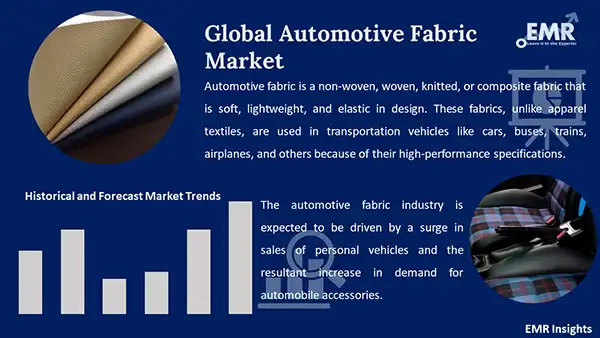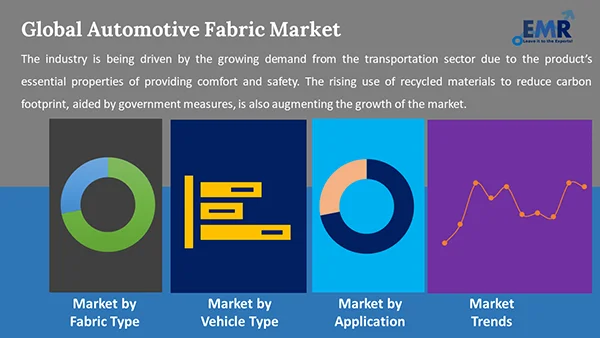
Consumer Insights
Uncover trends and behaviors shaping consumer choices today
Procurement Insights
Optimize your sourcing strategy with key market data
Industry Stats
Stay ahead with the latest trends and market analysis.
The global automotive fabric market attained a value of about USD 34.16 Billion in 2025. The market is further expected to grow in the forecast period of 2026-2035 at a CAGR of 5.00% to reach nearly USD 55.64 Billion by 2035.
Base Year
Historical Period
Forecast Period
Compound Annual Growth Rate
5%
Value in USD Billion
2026-2035
*this image is indicative*
The demand for automotive fabric is being driven by the transportation industry. Building on its essential properties, automotive fabrics help reduce the weight of the car, provide comfort, and improve the aesthetics and safety of the vehicle. Such favourable properties are aiding the growth of the industry. These fabrics are made up of textiles which carry high-performance specifications like the ability to withstand extreme temperatures and resist UV rays, along with being easy to clean, which is further bolstering the demand for the product. Automotive fabrics are widely used in public and commercial transportations like trains, buses, and airplanes, which require interiors to be more pleasing and relaxing. This is further favouring the growth of the market.

Read more about this report - REQUEST FREE SAMPLE COPY IN PDF
Technological innovations to for environmentally friendly and lightweight fabric materials to reduce pollution are accelerating the growth of the market. Growing efforts are being made to ensure that sustainable materials made from renewable sources are deployed in the interiors of the vehicle, which is also augmenting the growth of the automotive fabric industry. To minimise carbon footprint, recycled polyethylene terephthalate (RPET), a form of recycled polyester made from recycled plastic, is gradually becoming a popular choice of material, thereby boosting the market growth of automotive fabric.
Automotive fabric is a non-woven, woven, knitted, or composite fabric that is soft, lightweight, and elastic in design. These fabrics, unlike apparel textiles, are used in transportation vehicles like cars, buses, trains, airplanes, and others because of their high-performance specifications like their ability to withstand extreme temperatures, their cleaning properties, and durability. They are often used for auto upholstery and interior of the vehicles, including vehicle carpets, seatbelts, dashboard, seat covers, and others.
Market Breakup by Fabric Type
Market Breakup by Application
Market Breakup by Vehicle Type
Market Breakup by Region

Read more about this report - REQUEST FREE SAMPLE COPY IN PDF
Post the COVID-19 pandemic, the sales of personal vehicles are expected to rise due to the heightened health and hygiene consciousness as consumers become increasingly averse to travelling using public transportation. This is anticipated to aid the growth of the automotive fabric industry. Moreover, rapid urbanisation and flourishing disposable income levels, along with improved standards of living conditions, have increased the demand for automotive fabrics and are forecast to propel the market growth in the coming years. Aided by the safety measures adopted by governments across the world, automotive fabrics are widely in demand for usage in airbags and safety belts and are expected to continue to bolster the market growth. Further, the rising demand for environmentally friendly fabric material like recycled polyester and lightweight automotive fabrics to reduce pollution are also expected to drive the market towards growth.
Surging demand for automobile accessories to provide superior comfort and high-quality materials is expected to provide additional impetus to the market growth. These fabrics are designed to offer safety, comfort, and security while driving. Such factors are expected to propel the growth of the market.
The report presents a detailed analysis of the following key players in the global automotive fabric market, looking into their capacity, market share, and latest developments like capacity expansions, plant turnabouts and mergers and acquisitions.
The comprehensive report looks at the micro and macro aspects of the industry. The EMR report gives an in-depth insight into the market by providing a SWOT analysis as well as an analysis of the Porter’s Five Forces Model.




*While we strive to always give you current and accurate information, the numbers depicted on the website are indicative and may differ from the actual numbers in the main report. At Expert Market Research, we aim to bring you the latest insights and trends in the market. Using our analyses and forecasts, stakeholders can understand the market dynamics, navigate challenges, and capitalize on opportunities to make data-driven strategic decisions.*
Get in touch with us for a customized solution tailored to your unique requirements and save upto 35%!
In 2025, the market attained a value of nearly USD 34.16 Billion.
The market is projected to grow at a CAGR of 5.00% in the forecast period of 2026-2035.
The market is estimated to witness a healthy growth in the forecast period of 2026-2035 to reach USD 55.64 Billion by 2035.
The major market drivers include the increasing focus on aesthetic and safety of vehicles, growing demand for automobiles, the rising use of recycled materials to reduce carbon footprint, and increasing disposable incomes.
The key trends aiding the market demand are the surging sales of personal vehicles and the rising demand for automobile accessories.
The major regional markets for automotive fabric are North America, Latin America, Europe, the Asia Pacific, and the Middle East and Africa.
Polyester, vinyl, leather, and nylon, among others, are the major fabric types considered in the market report.
The various applications of automotive fabric are carpets/floor covering, upholstery, pre-assembled interior components, tyres, safety belts, and airbags, among others.
The significant vehicle types included in the market report are passenger vehicle and commercial vehicle.
The key players in the market are Acme Mills Company, Grupo Antolin Irausa S.A., Heathcoat Fabrics Limited., Lear Corporation, and Seiren Co., Ltd., among others.
Explore our key highlights of the report and gain a concise overview of key findings, trends, and actionable insights that will empower your strategic decisions.
| REPORT FEATURES | DETAILS |
| Base Year | 2025 |
| Historical Period | 2019-2025 |
| Forecast Period | 2026-2035 |
| Scope of the Report |
Historical and Forecast Trends, Industry Drivers and Constraints, Historical and Forecast Market Analysis by Segment:
|
| Breakup by Fabric Type |
|
| Breakup by Application |
|
| Breakup by Vehicle Type |
|
| Breakup by Region |
|
| Market Dynamics |
|
| Competitive Landscape |
|
| Companies Covered |
|
| Report Price and Purchase Option | Explore our purchase options that are best suited to your resources and industry needs. |
| Delivery Format | Delivered as an attached PDF and Excel through email, with an option of receiving an editable PPT, according to the purchase option. |
Datasheet
One User
USD 2,499
USD 2,249
tax inclusive*
Single User License
One User
USD 3,999
USD 3,599
tax inclusive*
Five User License
Five User
USD 4,999
USD 4,249
tax inclusive*
Corporate License
Unlimited Users
USD 5,999
USD 5,099
tax inclusive*
*Please note that the prices mentioned below are starting prices for each bundle type. Kindly contact our team for further details.*
Flash Bundle
Small Business Bundle
Growth Bundle
Enterprise Bundle
*Please note that the prices mentioned below are starting prices for each bundle type. Kindly contact our team for further details.*
Flash Bundle
Number of Reports: 3
20%
tax inclusive*
Small Business Bundle
Number of Reports: 5
25%
tax inclusive*
Growth Bundle
Number of Reports: 8
30%
tax inclusive*
Enterprise Bundle
Number of Reports: 10
35%
tax inclusive*
How To Order

Select License Type
Choose the right license for your needs and access rights.

Click on ‘Buy Now’
Add the report to your cart with one click and proceed to register.

Select Mode of Payment
Choose a payment option for a secure checkout. You will be redirected accordingly.
Gain insights to stay ahead and seize opportunities.

Get insights & trends for a competitive edge.

Track prices with detailed trend reports.

Analyse trade data for supply chain insights.

Leverage cost reports for smart savings

Enhance supply chain with partnerships.

Connect For More Information
Our expert team of analysts will offer full support and resolve any queries regarding the report, before and after the purchase.
Our expert team of analysts will offer full support and resolve any queries regarding the report, before and after the purchase.
We employ meticulous research methods, blending advanced analytics and expert insights to deliver accurate, actionable industry intelligence, staying ahead of competitors.
Our skilled analysts offer unparalleled competitive advantage with detailed insights on current and emerging markets, ensuring your strategic edge.
We offer an in-depth yet simplified presentation of industry insights and analysis to meet your specific requirements effectively.
Share